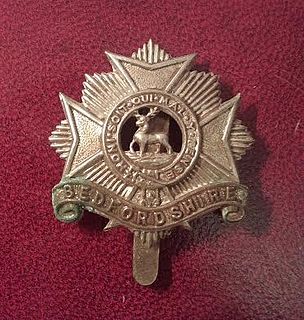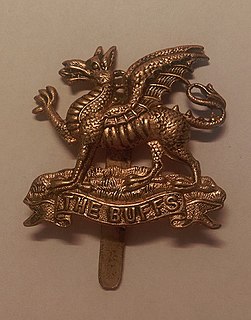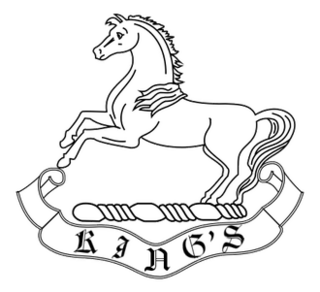 W
WThe Bedfordshire and Hertfordshire Regiment was the final title of a line infantry regiment of the British Army that was originally formed in 1688. After centuries of service in many small conflicts and wars, including both the First and Second World Wars, the regiment was amalgamated with the Essex Regiment in 1958 to form the 3rd East Anglian Regiment. However, this was short-lived and again was amalgamated, in 1964, with the 1st East Anglian Regiment and 2nd East Anglian Regiment, and the Royal Leicestershire Regiment to form the present Royal Anglian Regiment.
 W
WThe 5th Dragoon Guards was a British army cavalry regiment, officially formed in January 1686 as Shrewsbury's Regiment of Horse. Following a number of name changes, it became the 5th Regiment of Dragoon Guards in 1804.
 W
WThe Royal Lincolnshire Regiment was a line infantry regiment of the British Army raised on 20 June 1685 as the Earl of Bath's Regiment for its first Colonel, John Granville, 1st Earl of Bath. In 1751, it was numbered like most other Army regiments and named the 10th Regiment of Foot. After the Childers Reforms of 1881, it became the Lincolnshire Regiment after the county where it had been recruiting since 1781.
 W
WThe Royal Irish Regiment, until 1881 the 18th Regiment of Foot, was an infantry regiment of the line in the British Army, first raised in 1684. Also known as the 18th Regiment of Foot and the 18th Regiment of Foot, it was one of eight Irish regiments raised largely in Ireland, its home depot in Clonmel. It saw service for two and a half centuries before being disbanded with the Partition of Ireland following establishment of the independent Irish Free State in 1922 when the five regiments that had their traditional recruiting grounds in the counties of the new state were disbanded.
 W
WThe 3rd Dragoon Guards was a cavalry regiment in the British Army, first raised in 1685 as the Earl of Plymouth's Regiment of Horse. It was renamed as the 3rd Regiment of Dragoon Guards in 1751 and the 3rd Dragoon Guards in 1765. It saw service for two centuries, including the First World War, before being amalgamated into the 3rd/6th Dragoon Guards in 1922.
 W
WThe 5th Royal Irish Lancers was a cavalry regiment of the British Army. It saw service for three centuries, including the First World War. It amalgamated with the 16th The Queen's Lancers to become the 16th/5th Lancers in 1922.
 W
WThe Carabiniers was a cavalry regiment of the British Army. It was formed in 1685 as the Lord Lumley's Regiment of Horse. It was renamed as His Majesty's 1st Regiment of Carabiniers in 1740, the 3rd Regiment of Horse (Carabiniers) in 1756 and the 6th Regiment of Dragoon Guards in 1788. After two centuries of service, including the First World War, the regiment was amalgamated with the 3rd Dragoon Guards to form the 3rd/6th Dragoon Guards in 1922.
 W
WThe 7th Dragoon Guards was a cavalry regiment in the British Army, first raised in 1688 as Lord Cavendish's Regiment of Horse. It was renamed as the 7th Dragoon Guards for Princess Charlotte in 1788. It saw service for two centuries, including the First World War, before being amalgamated with the 4th Royal Irish Dragoon Guards, to form the 4th/7th Dragoon Guards in 1922.
 W
WThe Royal Welch Fusiliers was a line infantry regiment of the British Army and part of the Prince of Wales' Division, founded in 1689 shortly after the Glorious Revolution. In 1702, it was designated a fusilier regiment and became The Welch Regiment of Fusiliers; the prefix "Royal" was added in 1713, then confirmed in 1714 when George I named it The Prince of Wales's Own Royal Regiment of Welsh Fusiliers. After the 1751 reforms that standardised the naming and numbering of regiments, it became the 23rd Foot.
 W
WThe Buffs , formerly the 3rd Regiment of Foot, was a line infantry regiment of the British Army traditionally raised in the English county of Kent and garrisoned at Canterbury. It had a history dating back to 1572 and was one of the oldest regiments in the British Army, being third in order of precedence. The regiment provided distinguished service over a period of almost four hundred years accumulating one hundred and sixteen battle honours. In 1881, under the Childers Reforms, it was known as the Buffs and later, on 3 June 1935, was renamed the Buffs .
 W
WThe King's Regiment (Liverpool) was one of the oldest line infantry regiments of the British Army, having been formed in 1685 and numbered as the 8th Regiment of Foot in 1751. Unlike most British Army infantry regiments, which were associated with a county, the King's represented the city of Liverpool, one of only four regiments affiliated to a city in the British Army. After 273 years of continuous existence, the regiment was amalgamated with the Manchester Regiment in 1958 to form the King's Regiment, which was later amalgamated with the King's Own Royal Border Regiment and the Queen's Lancashire Regiment to form the present Duke of Lancaster's Regiment.
 W
WThe Carabiniers was a cavalry regiment of the British Army. It was formed in 1685 as the Lord Lumley's Regiment of Horse. It was renamed as His Majesty's 1st Regiment of Carabiniers in 1740, the 3rd Regiment of Horse (Carabiniers) in 1756 and the 6th Regiment of Dragoon Guards in 1788. After two centuries of service, including the First World War, the regiment was amalgamated with the 3rd Dragoon Guards to form the 3rd/6th Dragoon Guards in 1922.
 W
WThe 1st King's Dragoon Guards was a cavalry regiment in the British Army. The regiment was raised by Sir John Lanier in 1685 as the 2nd Queen's Regiment of Horse, named in honour of Queen Mary, consort of King James II. It was renamed the 2nd King's Own Regiment of Horse in 1714 in honour of George I. The regiment attained the title 1st King's Dragoon Guards in 1751. The regiment served as horse cavalry until 1937 when it was mechanised with light tanks. The regiment became part of the Royal Armoured Corps in 1939. After service in the First World War and the Second World War, the regiment amalgamated with the 2nd Dragoon Guards in 1959 to form the 1st The Queen's Dragoon Guards.
 W
WThe South Wales Borderers was a line infantry regiment of the British Army in existence for 280 years.
 W
WThe East Yorkshire Regiment was a line infantry regiment of the British Army, first raised in 1685 as Sir William Clifton's Regiment of Foot and later renamed the 15th Regiment of Foot. It saw service for three centuries, before eventually being amalgamated with the West Yorkshire Regiment in 1958, to form the Prince of Wales's Own Regiment of Yorkshire. Subsequently, the regiment amalgamated with the Green Howards and the Duke of Wellington's Regiment to form the Yorkshire Regiment on 6 June 2006.